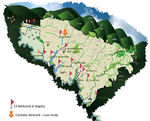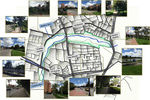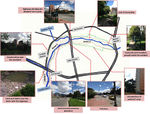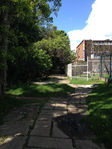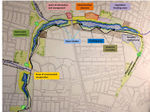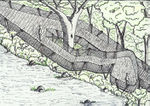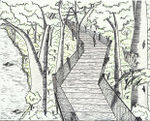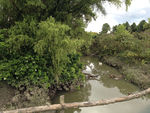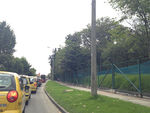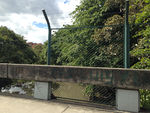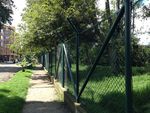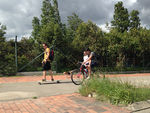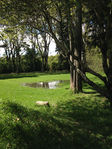Green Infrastructure 2014 Group C - Case Study 3: Difference between revisions
| Line 89: | Line 89: | ||
Image:Wetland Conflicts.jpg|Conflicts | Image:Wetland Conflicts.jpg|Conflicts | ||
Image:Section_of_the_Wetland.jpg|Section of Wetland | Image:Section_of_the_Wetland.jpg|Section of Wetland | ||
Image:Sector 3 of the Wetland.jpg|Low Constructions- Sector 3 | |||
</gallery> | </gallery> | ||
Revision as of 17:40, 1 December 2014
---> back to group page working group C
please add your title here
| Name | The Cordoba Wetland | |
| Country | Colombia | |
| City | Bogota | |
| Authors | Nataly Montoya | |

| ||
|
| ||
Rationale: Why is this case interesting?
The Cordoba wetland is one of the 13 wetlands of Bogota – Colombia. It is located in the northwest of its city in the Town of Suba, in an urban location with an area of 40.4 hectares. Wetlands are natural settings that for social and cultural reasons in the dynamic of the city have been immersed in an urban environment in which both its structure and function have been significantly altered. Córdoba Wetland besides being a lung for the city, it has a great natural wealth that needs to be preserved, a variety of flora and fauna can be seen in this specifically place. Although urban wetlands are protected areas and have the same physical conditions and benefits as non- urban wetlands, in the urban context they are exposed to a variety of harmful impacts, which deteriorates them and are making them disappear. The most common alterations have been draining, dredging, and filling of wetlands; modification of the hydrologic regime, highways construction; and water pollution.
Author's perspective
Since long ago I have been living in the town of Suba, the Cordoba wetland has been part of my life through many years, besides having a symbolic and practical value in the development of my everyday life; it is an important landmark in my area. Since I can remember this wetland has been forgotten, but in the last few years it has been recovering its identity and the value of the important role the Cordoba wetland plays in the city. Mankind has been responsible for the deterioration of these areas; due to rapid urban expansion without any planning process has developed conflicts in the conservation areas for native flora and fauna which induces an imbalance and loss of ecosystems. I consider that it should reach to a better understanding of the community to which we belong, and the future projects should involve adjacent communities in the protection and conservation of these areas, acquiring an identity that help us value our community and the surrounding environment.
Landscape and/or urban context of your case
Biogeography Wetlands are important productive ecosystems in the world. Its defining characteristic is the constant on water available throughout the year; this situation favours the successful development of a wide diversity of flora, fauna and microorganisms that interact in complex relationships to maintain a highly fragile ecological balance. In Colombia, factors such as climate and biogeographic location have combined to allow the water resource to be abundant and model tropical landscape in rivers, estuaries, swamps, wetlands and lagoons, among others. The wetland is fed by Cordoba and Molinos rivers. It is possible to find a great variety of fauna and flora, both microscopic and macroscopic organisms, some of them easy to see on a visit to the wetland. Among the most remarkable data about 70 species of resident and migratory birds plus 80 terrestrial and aquatic plant species are counted.
History and dynamics It is estimated that in the early twentieth century, the area occupied by lakes and wetlands in Bogotá, had more than 50,000 hectares. Of which today there are only 800 ha. The historical development shows the lack of wetland protection or conservation of these environments, but reveals a clear reduction process, deterioration, contamination, which implies a strong impact on the flora and fauna as valuable ecosystem. The lakes and wetlands located in the peripheral areas of the young Bogota fulfilled a leading role in the historical development of the city. They were a source of many products and were associated with some aspects of daily life. Fishing and boat tours were held in these spaces. In 1640 the colonial government ordered the construction of bridges and culverts, due to the overflow of rivers, streams, lakes and wetlands affected by the rise in the water level of the Bogotá River during the rainy season. In 1819, the city did not present a significant advance in its urban growth at that time, remaining distant from the areas occupied by lakes and wetlands. In the XX century, lakes and wetlands continued providing water for the farmers that were in its area of influence, but instead they received its sewage and the polluted water of the city. You can say that wetlands from colonial times, in addition to providing the nearby residents with hunting and fishing, provided the city with a collection service of solid, liquid and industrial waste, acting as large ponds and natural water treatment plants, although, to meet this laudable work, gradually they were losing its rich flora and fauna.
The Urban expansion Construction activity began in the early twentieth century was not enough for the demand for housing. According to data in the year 1928, 235,702 inhabitants of the city required 30,000 homes but there were only 17,767. This fact generated the emergence of suburbs, changing the face of the city. The city began to grow rapidly and began to build more roads, works that drove the growth of the city. By the 90s, Suba experienced strong urban development. In some cases, districts continued planning rules, but in many others, the neighbourhoods invaded not only rounds of wetlands, but based on illegal landfills were built on the body of water in these ecosystems.
Cultural Features, Overall Character, Current Status Cordoba Wetland is located in an urban area of the northwest of Bogota. It has 40.4 ha. and is part of the protected areas of the Capital District, under the name of Principal Ecological Structure. The Wetland is surrounded by two rivers polluted with sewage, the Cordoba River and the Molinos River. Although in the sides of the rivers exist a natural barrier to prevent them mixing with the wetland waters, at times of high rainfall collapse and the river water enters the lake. The wetland is divided by highways into 3 parts. The section between Suba Avenue and 127 Street (16.2 ha.) is characterized by having a high organic load. The section between Boyacá Avenue and Suba Avenue (21.4 ha.), is the largest with 53% of the total area of the wetland and the best preserved area in terms of environmental quality. The north section (2,8 ha.) in the 127 street is currently fed by rainwater from Avenue Cordoba and is considered the most neglected and polluted wetland section. The wetland has specific problems that arise basically in the limits with the avenues, such as trash, debris, presence of homeless people and insecurity, and other more complex as water pollution, water deficit, fragmentation, sedimentation and luminous and sonorous alteration. Despite these effects, Cordoba wetland continues providing important environmental functions such as water filtration; produce oxygen and retain CO2 and dust; be a noise barrier, and refuge for fauna and flora; also be suitable for passive recreation where direct contact with nature is possible within the urban area.
- Illustrations
Analytical drawings
- Please use analytical drawing for visualising the conflicts/potentials of your site
- Analytical Drawings
Green Infrastructure benefits for this site
Look again at the multiple benefits of green infrastructure - what could be achieved in your site and which are most relevant?
Despite the diverse Fauna and flora that can be found inside this ecosystem, the Cordoba wetland could benefit itself from the connectivity with other green infrastructures. Córdoba wetland connectivity with other protected areas of the district is made possible through ecological corridors which mostly correspond to the rounds of rivers, streams and canals in its watershed. The ecological corridors round comprise the hydraulic round and the area of environmental management and preservation of all those waterways that are not included within other categories of the main structure: aim at urban forestry, protection of birds, bike paths, alleys and passive recreation in the area of hydraulic round. Finally Wetland Cordoba can be connected with elements of public space system, which is integrated with other elements of the main ecological structure, in order to improve environmental conditions and living conditions of the city.
Potential for multifunctionality
Green infrastructure has typically multiple functions. What could be achieved for your site in this respect?
The Cordoba Wetland has great potential for being an element of Green infrastructure. Wetlands play a number of roles in the environment, but considering the issues of being located in an urban area and all the problems for what mankind has been the principal responsible; all of these functions have been affected. The Cordoba wetland can be led to a Healthy Ecosystem providing multiple benefits such as enhancing flood alleviation, local climatic amelioration, improving air quality, providing better conditions for biodiversity, providing green space for passive recreation and a close interaction for educational purpose, increasing health and well-being benefits not only for the different species that inhabit the wetland but also for the surrounding community.
Projective drawings
- How would you like this case to change in the near future? (in 1-2 years)
- you may add a short explanation here
-Achieve the approach and involvement of neighbouring communities, institutions and community organizations, to the social management for recovery and comprehensive wetland conservation.
-Create points and environmental classrooms within the wetland to develop environmental education processes around the wetland allowing the development of knowledge, values, attitudes and behaviours that provide more responsible and respectful actions with the wetland and life that houses this ecosystem.
-Reforestation programs activities of natural and induced vegetation way with species native to the system.
-Enhance the permeability to these areas by paths made of environment friendly materials, having an adequate approach to these ecosystems within the city, providing spaces for passive recreational activities, acquiring ownership and valuation of these spaces that fulfill a function of green space within an urban area, with spaces for the development of recreational and leisure activities in a healthy environment.
- And how could it look like in 10-15 years?
- you may add a short explanation here
-Achieve the connection of different areas of green infrastructure with the wetland, helping to preserve and enhance the livability of its inhabitants.
-Achieve the total restoration of this ecosystem and the recuperation of the water sources. This will provide a much better habitat for fauna and flora, and also for the surrounding community.
-Achieve total wetland management by public authorities and neighbouring communities for proper conservation of the wetland. Having as a result, a healthy ecosystem of great appeal for citizens and tourists wishing to visit this place for recreational and educational purposes.
- Projective Drawings
Summary and conclusion
- 100 words approx.
The Cordoba wetland emerges as a residual space that should be integrated into the urban community that surrounds it. Its biodiversity and its ecosystem services deserve special attention. I think we must recognize nature as other with rights and seek the preservation of this spaces and get to see it as a wildlife sanctuary. Whereas the nature apart from its ecosystem services that provides, gives very significant and meaningful experiences that give meaning to life, must then exist a balance between mankind and nature and achieve to harmonize the conservation of natural areas with other types of land use.
Image Gallery
Please add further images/photos here
- Image Gallery
- Yourimage.jpg
your image text
References
- please add your references here
http://es.wikipedia.org/wiki/Humedal_de_C%C3%B3rdoba
http://www.slideshare.net/PtrColombian/diario-de-campo-del-humedal-de-cordoba
http://www.terra.com.co/investigaciones/medio-ambiente/la-lucha-de-un-sobreviviente.html
http://www.acueducto.com.co/wpsv61/wps/html/swf/revistas/revista_hum/HUMEDALES.html
COLCIENCIAS, Construccion de Lugares-patrimonio, el Centro Historico y el humedal de Corboda de bogota. Adriana Parias Dura & Dolly Cristina Palacios Tamayo.
John Wiley & Sons, inc, WETLANDS, fourth edition, William J. Mitsch and James G. Gosselink
Architect Natalia Vergara Forero, IMLA MASTER THESIS, Wetland el Burro, Bogota.
About categories: You can add more categories with this tag: "", add your categories

